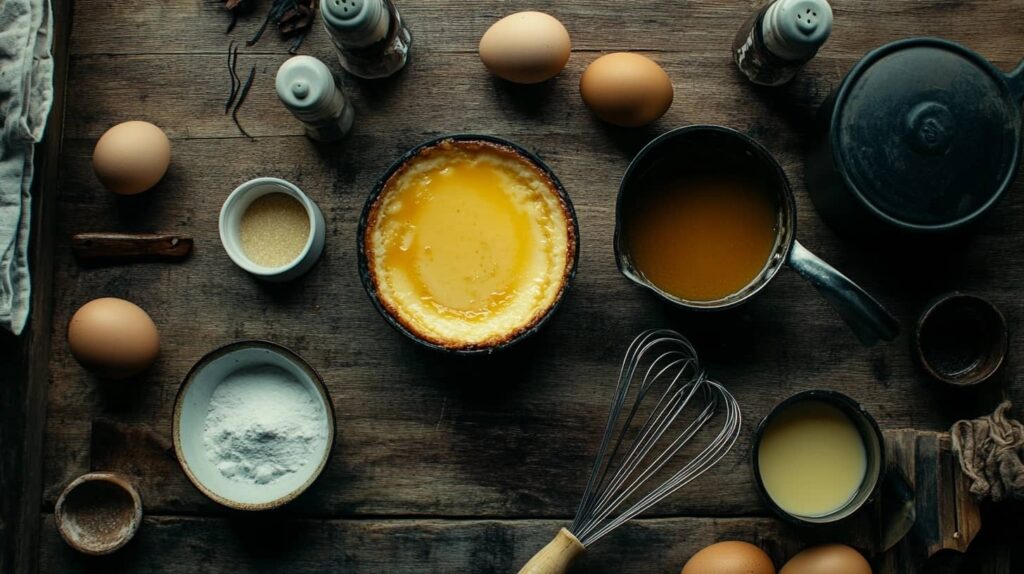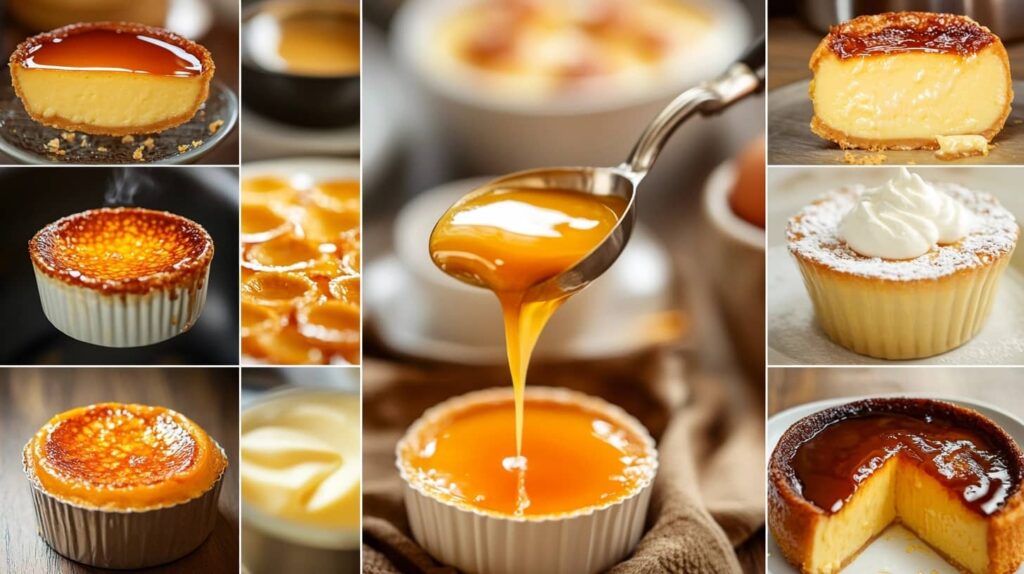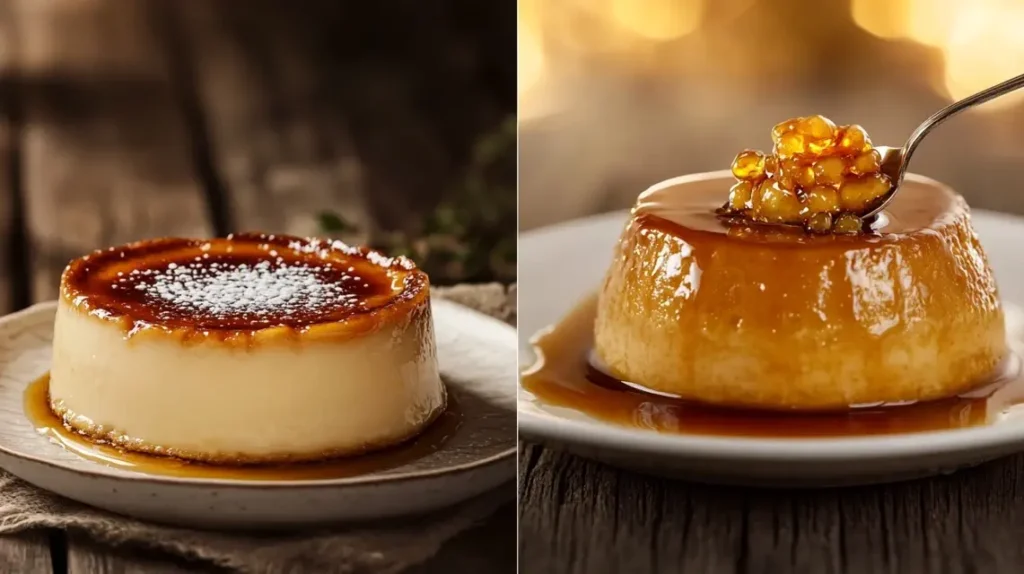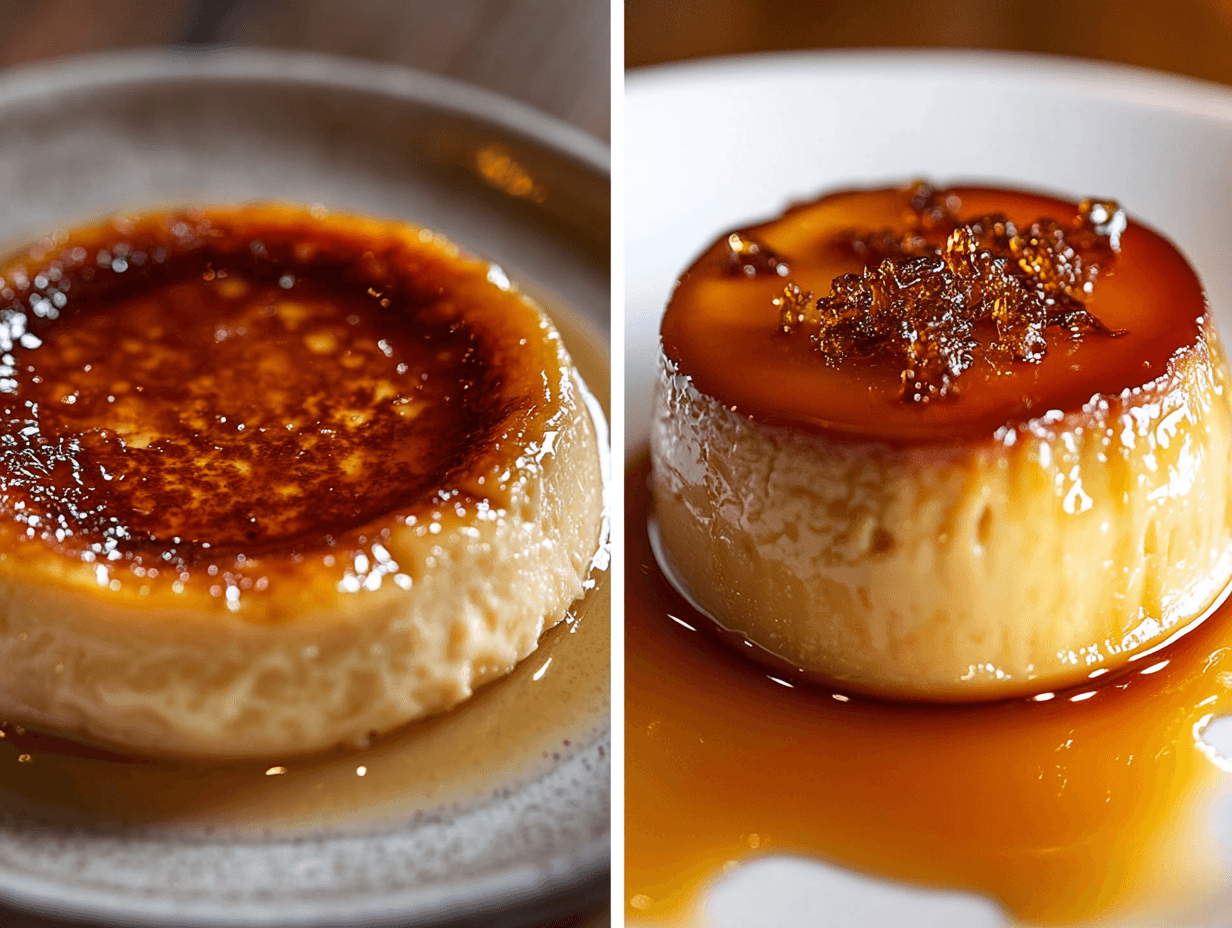Imagine this: You’re at a fancy restaurant, scanning the dessert menu. Your eyes land on crème brûlée and flan—two elegant, caramel-covered treats. You pause. “Aren’t they basically the same thing?” you wonder.
The waiter approaches. You ask, “Does Crème Brûlée Taste Like Flan?” He smiles and says, “Well, one has a crisp, caramelized top, and the other is silky smooth with a gooey caramel sauce.”
Confused but intrigued, you take a leap and order both. The first bite of each sends your taste buds into a whirlwind of creamy textures and rich flavors. But the real question lingers—do they actually taste the same?
What is Crème Brûlée?
Origin and History of Crème Brûlée
Crème brûlée is a dessert that screams luxury. Its name is French, meaning “burnt cream,” but its origins are a bit of a mystery. Some say it was first created in France, others claim England or Spain. But one thing is clear—this dessert has been delighting sweet tooths for centuries!
Ingredients and Preparation Method
Crème brûlée is a simple yet elegant dessert, made with just a few ingredients:
| Ingredient | Quantity |
|---|---|
| Heavy cream | 2 cups |
| Egg yolks | 4 |
| Sugar | ½ cup |
| Vanilla extract | 1 tsp |
| Sugar (for topping) | 2 tbsp |

🔹 How is it made?
- Heat the cream—but don’t let it boil!
- Whisk the egg yolks and sugar until smooth.
- Combine the warm cream and egg mixture slowly to avoid scrambling.
- Pour into ramekins and bake in a water bath.
- Chill, then top with sugar and caramelize it with a torch!
Texture, Flavor, and Presentation
Crème brûlée is rich, velvety, and creamy, with a crunchy caramelized top that shatters like thin glass when you tap it with a spoon. The flavor? Think sweet, custardy vanilla with a hint of caramel bitterness.
For an exciting comparison of other caramel-flavored desserts, you can explore recipes and cooking tips on What Does Crème Brûlée Taste Like? A Complete Guide.
What is Flan?
Origin and History of Flan
Flan has a much longer history, dating back to the Roman Empire! The Spanish later perfected it, making it one of the most beloved desserts in Latin America and beyond.
Ingredients and Preparation Method
Flan is also made with a handful of ingredients, but there’s a small twist:
| Ingredient | Quantity |
|---|---|
| Milk (or evaporated milk) | 1 ½ cups |
| Sweetened condensed milk | 1 can (14 oz) |
| Eggs | 3 |
| Sugar | ½ cup |
| Vanilla extract | 1 tsp |
| Water (for caramel) | ¼ cup |
🔹 How is it made?
- Melt sugar with water to create a golden caramel syrup.
- Pour the caramel into a baking dish.
- Blend eggs, milk, and vanilla into a smooth mixture.
- Pour over the caramel and bake in a water bath.
- Cool and flip it upside down to reveal a glossy caramel top!
Texture, Flavor, and Presentation
Flan is silky, jiggly, and smooth, with a deep caramel sauce that soaks into every bite. It’s sweeter than crème brûlée with a light, milky flavor.
Comparing Crème Brûlée and Flan: Similarities and Differences
Key Ingredients: How They Influence Taste
Both desserts use eggs, sugar, and dairy, but crème brûlée is heavier on cream, while flan relies on milk, making it lighter.
Texture and Consistency: Creamy or Jiggly?
- Crème brûlée: Thick, creamy, and spoon-coating.
- Flan: Soft, bouncy, and jiggly like jelly.
Sweetness and Caramelization: A Matter of Preference
- Crème brûlée has a crunchy caramel topping.
- Flan has a liquid caramel sauce that seeps into the custard.
Serving and Presentation Styles
- Crème brûlée: Served in a ramekin, eaten with a spoon.
- Flan: Turned upside down, revealing its caramel crown.

Does Crème Brûlée Taste Like Flan? The Verdict
Flavor Profile Breakdown
“Both are custards, but they dance on your palate in different ways.”
- Flan is lighter, milky, and caramel-forward.
- Crème brûlée is richer, smoother, and more vanilla-heavy.
Which One is Sweeter?
Flan is generally sweeter, thanks to the condensed milk and caramel sauce.
Which One is Richer?
Crème brûlée wins! The heavy cream makes it ultra decadent.
Which One Has a More Complex Taste?
Crème brûlée has more flavor contrast—the bitterness of caramelized sugar balances the sweetness.
For more sweet inspirations, explore delicious recipes at Crab Brulee Recipe: A Savory Twist on a Classic Dessert.
Recipes: How to Make Crème Brûlée and Flan at Home
Classic Crème Brûlée Recipe
Follow the ingredient list above and remember:
- Use a torch for that perfect caramel crust!
- Chill well before serving.
Traditional Flan Recipe
Again, stick to the ingredient table and don’t forget:
- Don’t overcook, or it’ll be too firm.
- Flip carefully so the caramel sauce flows beautifully.
Common Problems and Solutions When Making Crème Brûlée and Flan
Why is My Crème Brûlée Not Setting?
🔹 Your oven might be too cool! Bake at 325°F (160°C).
Why is My Flan Too Watery or Hard?
🔹 You either undercooked or overcooked it. Stick to the recommended time!
How to Get the Perfect Caramel Topping?
🔹 For crème brûlée: Use a torch to caramelize the sugar evenly.
🔹 For flan: Melt sugar slowly to avoid burning it.
FAQ: Crème Brûlée vs. Flan
Got more questions? No worries! Here’s a list of frequently asked questions to help clear up any confusion about crème brûlée and flan.
1. Does crème brûlée taste like flan?
Not exactly! While both are custard-based desserts, they have different textures and flavors.
- Crème brûlée is richer, creamier, and less sweet, with a crunchy caramelized top.
- Flan is lighter, jiggly, and sweeter, with a liquid caramel sauce.
2. Which is sweeter—crème brûlée or flan?
Flan is sweeter! It usually contains sweetened condensed milk, which makes it noticeably sweeter than crème brûlée.
3. Can I flip crème brûlée like flan?
Nope! Crème brûlée is served directly in the ramekin because its caramelized top is not a liquid sauce like flan’s.
4. Can I make flan in individual ramekins like crème brûlée?
Absolutely! Flan is traditionally made in one large mold, but you can bake it in small ramekins for individual servings—just adjust the baking time accordingly.
5. Which is easier to make—crème brûlée or flan?
Flan is slightly easier and more forgiving because it doesn’t require caramelizing sugar on top. However, both desserts are pretty simple with the right technique.

Conclusion: The Best Choice for Your Sweet Tooth
So, does crème brûlée taste like flan? Not quite! While they share a custard base, they’re unique in texture, sweetness, and experience.
At the end of the day, it’s all about what you’re in the mood for. Velvety richness or smooth, caramel-drenched goodness? Whatever you pick, one thing’s for sure—you’re in for a delicious treat!
For step-by-step instructions on creating perfect caramel-based desserts, check out What Flavor is Similar to Crème Brûlée? Discovering the Creamy, Sweet World of Similar Flavors.

Classic Crème Brûlée
Equipment
- Ramekins
- Kitchen Torch
- Baking Dish
- Whisk
Ingredients
Crème Brûlée Base
- 2 cups heavy cream
- 4 egg yolks
- 1/2 cup sugar
- 1 tsp vanilla extract
Caramelized Sugar Topping
- 2 tbsp sugar for topping
Instructions
- Preheat the oven to 325°F (160°C).
- Heat the heavy cream in a saucepan over medium heat, but do not let it boil.
- In a separate bowl, whisk together the egg yolks and sugar until smooth and pale.
- Gradually pour the warm cream into the egg mixture, whisking constantly to prevent scrambling.
- Stir in the vanilla extract.
- Pour the mixture into ramekins and place them in a baking dish. Add hot water to the baking dish until it reaches halfway up the sides of the ramekins.
- Bake for about 30 minutes, or until the custard is set but still slightly wobbly in the center.
- Remove from the oven and let them cool to room temperature, then refrigerate for at least 2 hours.
- Before serving, sprinkle sugar evenly on top of each custard and caramelize using a kitchen torch until golden and crispy.
- Let the sugar topping harden for a minute, then serve immediately.

